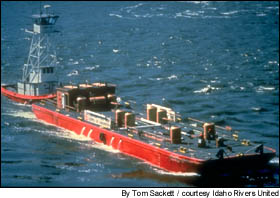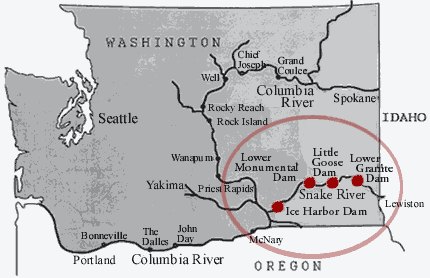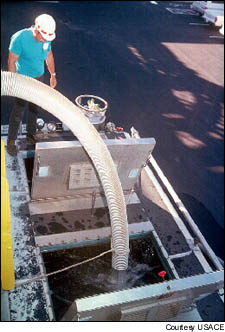forum
library
tutorial
contact

Corps Barging in on Salmon Recovery, say Conservationists
by Margot HigginsEnvironmental News Network, August 26, 2000
|
the film forum library tutorial contact |

|
Corps Barging in on Salmon Recovery, say Conservationistsby Margot HigginsEnvironmental News Network, August 26, 2000 |
 Salmon and steelhead trout evolved to ride the natural wave of spring snowmelt
each year from their freshwater birthing grounds to the ocean.
Salmon and steelhead trout evolved to ride the natural wave of spring snowmelt
each year from their freshwater birthing grounds to the ocean.
Historically, the fish would be swept, tail first, down the Snake and Columbia rivers, for one to three weeks before they reached the Pacific Ocean.
Today, the means of travel is different.
Eighty-five percent of endangered Snake River salmon and steelhead smolts were artificially transported by the U.S. Army Corps of Engineers during the 2000 migration season, conservation groups report.
According to data released this week by the Fish Passage Center in Portland, the proportion of juvenile salmon transported to barges and trucks this year was the highest ever recorded.
"They are basically collecting every fish they can get their hands on," said Scott Bosse, a fisheries biologist at Idaho Rivers United."(The Corps) is using technological mechanisms to corral juvenile fish into pipes that eventually dump them into barges or trucks."
 Environmentalists have strongly argued for the removal of the four lower Snake
River dams as the best way to recover endangered salmon and steelhead
populations. If the dams are not removed, they say, the natural flow of the river
will need to be restored.
Environmentalists have strongly argued for the removal of the four lower Snake
River dams as the best way to recover endangered salmon and steelhead
populations. If the dams are not removed, they say, the natural flow of the river
will need to be restored.
"That means spilling water over the dams from spring until fall, 24 hours a day, as opposed to using turbines," Bosse said.
Bosse notes that the biological opinion issued by the National Marine Fisheries Service required more water for moving salmon through the river system and a change in dam operations to increase the survival of the fish moving through the facilities.
A draft revision of the opinion, ordered by a federal court, softens that requirement.
"The report calls for more water flow on a voluntary basis," Bosse said. "It does not require any one that is involved to make sacrifices. The new plan relies on maximum fish barging. This is not the aggressive non-dam breaching plan NMFS said it was going to be. It's a passive, non-breaching plan."
Irrigators in Idaho and eastern Washington are opposed to increasing river flows for salmon recovery.
"The reason the barge system remains is political, not because it's good for the fish," said Earl Webber, a biologist with the Columbia River Inter Tribal Fish Commission. "The agricultural industry wants to maintain Lewiston as a seaport. As long as the barge system for fish remains in tact, the region will automatically have a barging system for wheat."
According to David Hurson, a fisheries biologist who oversees the fish transportation program for the corps, recent studies by the National Marine Fisheries Service show that "the relationship between water flow and salmon survival is not as strong as they once thought it was."
Hurson said the fish transportation program gained momentum during the 1980s.
"At the present stage, all research shows that transported fish return at a higher rate than non-transported fish," he said. "We believe flow helps with survival to a point, but other measures have to come into place."
 Environmentalists cite a February 1999 report by the Independent Scientific Advisory Board, which oversees Columbia basin salmon recovery efforts. The
board criticized the corps for barging the vast majority of young salmon. "It is
impossible to reconcile a maximum transport approach to salmon recovery with
protection of the remaining diversity of salmon and steelhead populations in the
Snake River basin," the report concluded.
Environmentalists cite a February 1999 report by the Independent Scientific Advisory Board, which oversees Columbia basin salmon recovery efforts. The
board criticized the corps for barging the vast majority of young salmon. "It is
impossible to reconcile a maximum transport approach to salmon recovery with
protection of the remaining diversity of salmon and steelhead populations in the
Snake River basin," the report concluded.
Hurson contends "transportation puts the salmon migration back on schedule." Environmentalists say it disturbs Mother Nature's clock.
"Juvenile salmon have a biological clock that begins ticking as soon as they begin their trip to the ocean," Bosse explained. "They need to undergo changes that will allow them to adapt from fresh water creatures to salt water creatures and arrive at the ocean at the same time their bodies have completed the transformation."
According to Bosse, barging disrupts that cycle by completing the last 465-mile journey from Lower Granite Dam to the Columbia River Estuary, where freshwater and saltwater mix, in a day and a half instead of a couple of weeks. "That's the equivalent of taking a human at sea level and transporting him to the top of Everest and expecting him to adapt right away."
When the fish are released into the estuary, they tend to gravitate to a thin layer of freshwater at the surface, Bosse noted. "This puts the fish at great risk of being eaten by a number of predators."
Conservationists also claim that disease is rampant in barges.
Hurson allowed that "there may be an increase in disease transmission from one fish to another in the barges," but he added, "Our research has not shown this to be a significant problem."
Conservationists say all the factors add up. Less than 2 percent of the smolts return to the rivers as adult salmon. In order to restore the populations, biologists say they need a return of between 4 and 6 percent.
"Smolting is the most sensitive time in (a fish's) life," Bosse said. "Increased exposure to disease and predation means a lot of delayed mortality."
learn more on topics covered in the film
see the video
read the script
learn the songs
discussion forum
